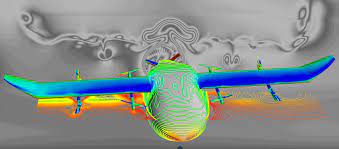“…Computer simulation of a potential air taxi stabilization system at work. As a wing moves down, due to tipping and rocking triggered by a gust of wind, the propellers on that side are activated to counter the downward motion. Around the active propellers, red and orange indicate high mach numbers, a measure of an object’s speed relative to the speed of sound. Colors on the aircraft represent surface pressure, where red is positive and blue is negative. The black and gray contours behind the aircraft indicate variation in airflow speeds, ranging from low in black to high in white.
When air taxis begin shuttling us around, the rides they offer will need to be safe and smooth. These small electric aircraft will be nimble enough to operate in cities, but sudden gusts of wind could cause a turbulent flight – for example, by setting off an up-down movement of the wings combined with rocking side to side. To nip that unstable motion in the bud, NASA is researching a system that could actively suppress it, with the help of high-performance computer simulations.
This video shows a computer simulation of the system at work. A generic concept design for an air taxi has begun to tip and rock following an unexpected wind gust. As the wing to the viewer’s right begins to move down, the outer propellers on that side spin extra fast to lift the wing back up – visualized as an airflow pattern in bright orange, indicating their high rotation speed. The farther down the wing is tipped, the faster the propellers rotate. The process alternates between the wings until the unstable motion has stopped.
Complex computer simulations help researchers assess their potential systems and make them better. The computations needed to evaluate the conceptual system for active air taxi stabilization shown here required the capabilities of the Pleiades supercomputer at the NASA Advanced Supercomputing facility at NASA’s Ames Research Center in California’s Silicon Valley. The successful simulation demonstrates how high-powered computers can help assess air vehicles for NASA’s work in Advanced Air Mobility and help improve safety in future vehicles.
NASA is showcasing 39 of the agency’s science, engineering, and technology achievements, including this simulation, at SC21, the international supercomputing conference, Nov. 14-19, 2021, in St. Louis. For more technical information, visit: https://www.nas.nasa.gov/sc21
